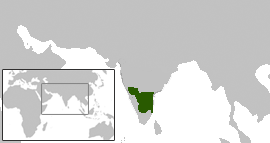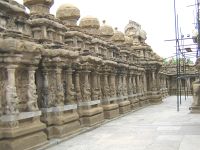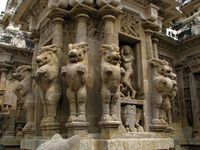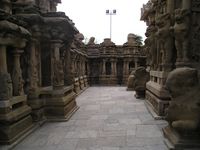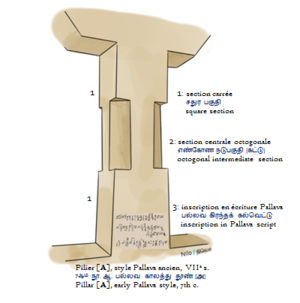أسرة پلاڤا
| ||||||||||||||||||||||||||||||||||||||||||||||
| قالب:Pallava | ||||||||||||||||||||||||||||||||||||||||||||||
| ||||||||||||||||||||||||||||||||||||||||||||||
أسرة پلاڤا Pallava dynasty كانت أسرة حاكمة هندية تواجدت من 275م إلى 897م، وحكمت جزءاً من جنوب الهند. وقد حازوا الصدارة بعد قفول نجم أسرة ساتاڤاهانا، التي كان الپلاڤا يعملون لديهم كأمراء إقطاع.[2][3]
أصبح الپلاڤا قوة رئيسية في عهدي ماهندراڤارمان الأول (571 – 630 م) و ناراسماڤارمان الأول (630 – 668 م) وهيمنوا على التلوگو والأجزاء الشمالية من منطقة التامل لنحو 600 سنة حتى نهاية القرن التاسع. وطوال عهدهم كانوا في صراع دائم مع كلٍ من چالوكيا بدمي في الشمال وممالك التامل تشولا و پانديا في الجنوب. وفي النهاية انهزم الپلاڤا على يد أديتيا الأول من التشولا في القرن التاسع.[4]
أهم ما اشتهر به الپلاڤا كان رعايتهم للعمارة، وأفضل مثال على ذلك هو معبد الشاطئ، الذي هو موقع تراث عالمي لليونسكو في مهاباليپورم. الپلاڤا، الذين خلـَّفوا وراءهم نحوتاً ومعابد رائعة، أرسوا أسس عمارة جنوب الهند. وقد طوّروا كتابة الپلاڤا التي انحدرت منها أبجدية گرانتا. كما أطلقت كتابة الپلاڤا عدداً من نظم الكتابة في جنوب شرق آسيا. الرحالة الصيني شوانزانگ زار كنچيپورم في عهد الپلاڤا وامتدح حكمهم الرشيد.
الأصول
There were numerous theories about the origin of Pallavas.[5] According to many notable scholars like Gabriel Jouveau, N.S Ramaswamy early pallavas originated in Andhradesa, which forms present day Andhra region and then extended till كنچيپورم of present day Tamilnadu.[6][7]The early literary works of pallavas were traced in Prakrit and sanskrit from third century to sixth centuary and tamil literary records of pallavas were only available from seventh century.[8]
اللغات المستعملة
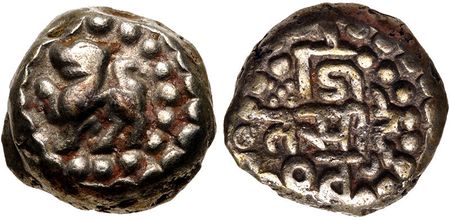
نظام الكتابة
Under the Pallava dynasty, a unique form of Grantha script, a descendant of Pallava script which is a type of Brahmic script, was used. Around the 6th century, it was exported eastwards and influenced the genesis of almost all Southeast Asian scripts.
الدين
Pallavas were followers of Hinduism and made gifts of land to gods and Brahmins. In line with the prevalent customs, some of the rulers performed the Aswamedha and other Vedic sacrifices.[9] They were, however, tolerant of other faiths. The Chinese monk Xuanzang who visited كنچيپورم during the reign of Narasimhavarman I reported that there were 100 Buddhist monasteries, and 80 temples in كنچيپورم.[10]
عمارة پلاڤا
التأريخ
الپلاڤا المبكرون
- سماڤارمان الأول (275–300)
- سكنداڤارمان (غير معروف)
- ڤشنوگوپا (350–355)
- كوماراڤشنو الأول (350–370)
- سكنداڤارمان الثاني (370–385)
- ڤيراڤارمان (385–400)
- سكنداڤارمان الثالث (400–436)
- سماڤارمان الثاني (436–460)
- سكنداڤارمان الرابع (460–480)
- نانديڤارمان الأول (480–510)
- كوماراڤشنو الثاني (510–530)
- بوذاڤارمان (530–540)
- كوماراڤشنو الثالث (540–550)
- سماڤارمان الثالث (550–560)
علاقات أخرى
Pallava royal lineages were influential in the old kingdom of Kedah of the Malay Peninsula under Rudravarman I, Champa under Bhadravarman I and the Kingdom of the Funan in Cambodia.[11]
انظر أيضاً
الهامش
- ^ جفنا القديمة: Being a Research Into the تاريخ جفنا من أقدم العصور إلى العصر البرتغالي، C. Rasanayagam, p.241, Asian Educational Services 1926
- ^ The journal of the Numismatic Society of India, Volume 51, p.109
- ^ Alī Jāvīd and Tabassum Javeed. (2008). World heritage monuments and related edifices in India, p.107 [1]
- ^ Gabriel Jouveau-Dubreuil. The Pallavas. Asian Educational Services, 1995 - Art, Indic - 86 pages. p. 83.
- ^ Chaurasia, Radhey Shyam. History of Ancient India: Earliest Times to 1000 A. D. (in الإنجليزية). Atlantic Publishers & Dist. ISBN 9788126900275.
- ^ Jouveau-Dubreuil, Gabriel (1995). The Pallavas (in الإنجليزية). Asian Educational Services. ISBN 9788120605749.
- ^ Ramaswami, N. S. (1975). Amaravati, the art and history of the stupa and the temple (in الإنجليزية). Govt. of Andhra Pradesh.
- ^ Kumar, Raj (2008). Encyclopaedia of Untouchables Ancient, Medieval and Modern (in الإنجليزية). Gyan Publishing House. ISBN 9788178356648.
- ^ خطأ استشهاد: وسم
<ref>غير صحيح؛ لا نص تم توفيره للمراجع المسماةsastri92 - ^ Kulke and Rothermund, pp121–122
- ^ Cœdès, George (1968-01-01). The Indianized States of South-East Asia. University of Hawaii Press. ISBN 9780824803681.
المراجع
- Avari, Burjor (2007). India: The Ancient Past. New York: Routledge.
- Hermann, Kulke; Rothermund D (2001) [2000]. A History of India. Routledge. ISBN 0-415-32920-5.
- Minakshi, Cadambi (1938). Administration and Social Life Under the Pallavas. Madras: University of Madras.
- Prasad, Durga (1988). History of the Andhras up to 1565 A.D. Guntur, India: P.G. Publishers.
- Raghava Iyengar, R (1949). Perumbanarruppatai, a commentary. Chidambaram, India: Annamalai University Press.
وصلات خارجية
قالب:Tribes and kingdoms of the Mahabharata
| أظهرالممالك الوسطى في الهند |
|---|
- Short description matches Wikidata
- Articles with hatnote templates targeting a nonexistent page
- Portal-inline template with redlinked portals
- Pages with empty portal template
- أسرة پلاڤا
- ملوك تامل
- History of Tiruchirappalli
- دول وأقاليم تأسست في القرن الثالث
- دول وأقاليم انحلت في القرن التاسع
- تأسيسات القرن الثالث في الهند
- انحلالات القرن التاسع في الهند
- ملوك تلوگو
